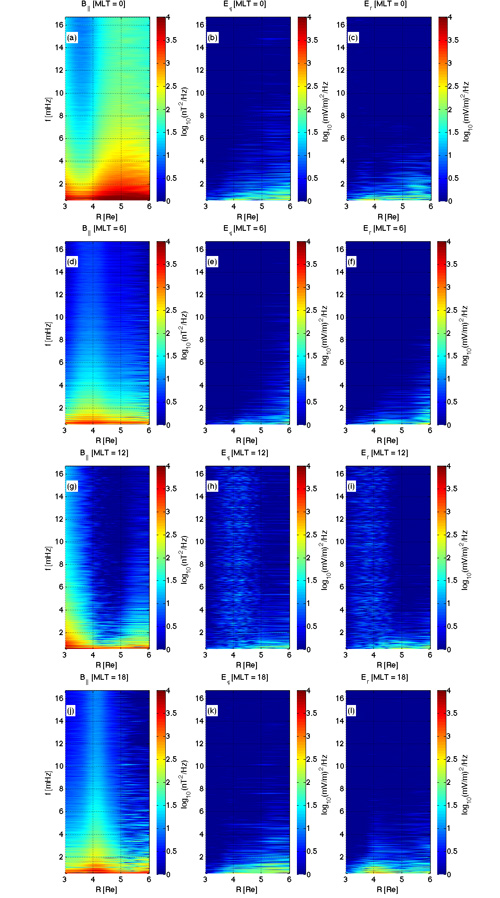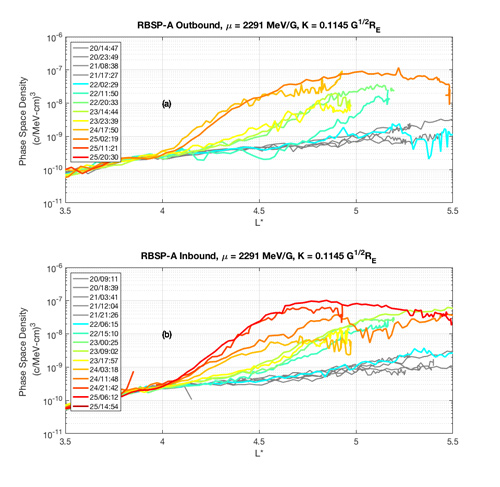
2019 THEMIS SCIENCE NUGGETS
Contribution of ULF wave activity to the global recovery of the outer radiation belt during the passage of a high-speed solar wind stream observed in September 2014
by Ligia Alves Da Silva
State Key Laboratory of Space Weather, National Space Science Center, Chinese Academy of Sciences, China
Clima Espacial / Instituto Nacional de Pesquisas Espaciais - EMBRACE/INPE, Sao Jose dos Campos, SP, Brazil
Introduction
Energy coupling between the solar wind and the Earth's magnetosphere can affect the outer radiation belt, resulting in enhancement or losses of certain electron populations. The precise role of different internal and external mechanisms that lead to changes in the relativistic electron population is not entirely known. This paper describes how Ultra Low Frequency (ULF) wave activity during the passage of Alfvénic solar wind streams contributes to the global recovery of the relativistic electron population in the outer radiation belt. The global recovery started on Sep 22, 2014, which coincides with a corotating interaction region preceding a high-speed stream, and the occurrence of persistent substorm activity. To support our analyses, we employed ground and space-based observational data, global magnetohydrodynamic (MHD) simulations, and calculation of the ULF wave radial diffusion coefficients employing an empirical model.
Solar wind conditions and the high-energy electron flux
Figure 1 presents observations from the Earth's radiation belt and solar wind conditions by the Van Allen Probes (RBSP) from September 22 to 25, 2014. The outer belt electron flux increased significantly within ~ 14 hours. The flux changes coincided with two IMF features: (i) a turning of the Bz component from an average northward (Bz>0) to an average southward (Bz<0) orientation, and (ii) a sector boundary crossing, as seen, respectively, in panels (c) and (b). Upon close inspection of Figure 1, the enhanced speeds and/or densities of the solar wind commonly associated with ULF wave generation in the magnetosphere are absent. During this period we only see a change in the heliospheric current sheet sector which is accompanied by substorm activity (panel (e)) and the presence of both southward, on average, IMF Bz (thick line on panel (c)), and IMF Alfvénic fluctuations.
| Figure 1. (a) the electron fluxes, 1.8 MeV, 2.10 MeV, 2.6 MeV and 3.4 MeV to L*=5.3; (b) Bx and By component of the IMF; (c) the Interplanetary Magnetic Field (IMF) intensity (Bt) and Bz component of the IMF (solid red line represents a 4-hour running average); (d) solar wind density (Np); (e) geomagnetic Auroral Electrojet - AE Index. The electron fluxes are obtained by the REPT instrument on board of the Van Allen Probes A. The Np, Bt, Bz, Bx and By are obtained by the Advanced Composition Explorer (ACE) satellite in the Lagrangian L1 point. AE Index is obtained at the World Data Center for Geomagnetism (WDC), Kyoto. |
ULF wave activity observed
Figure 2 presents the ULF wave power spectral density (PSD), a Fourier spectral analysis that we apply to the ULF wave (magnetic and electric field) data to identify the power of these waves. Observations are from Van Allen Probes EMFISIS/EFW instruments on September 22 (top panels (a), (b) and (c)) and on September 24 (lower panels (d), (e) and (f)). This figure has six panels, the panels show the ULF waves PSD calculated for the parallel magnetic field B∥ (two left panels), azimuthal electric compent Eφ; (two middle panels) and radial electric component Er (two right panels) components during two of the three Van Allen Probes orbits. Comparing the PSDs seen in panels (b) and (c) with (e) and (f) we see that the toroidal mode predominates over the poloidal one during the whole period. Furthermore, panels (a) and (d), compared with panels (c) and (f) show that both compressional and Alfvénic waves activity increased from September 22 to 24.
| Figure 2. The ULF power spectral density (color's scale) as a function of frequency (vertical axis) and spacecraft's radial distance (horizontal axis) on September 22 and 24, 2014. Data from both EMFISIS and EFW instruments on board Van Allen Probe A were used. The top row a-c panels are referring to the first orbit on September 22, and lower panel d-f are referring to the second orbit on September 24. The parallel magnetic component (B∥), azimuthal electric component (Eφ) and radial electric component (Er) are shown in the first, second and third column, respectively. |
ULF wave activity simulated
To get a broader view of ULF wave activity in the magnetosphere, we proceed to the simulation of this event. Figure 3 presents the ULF wave PSD for the simulated magnetosphere on September 24. To evaluate the model reliability, we show (panels (d) to (f)) the ULF wave PSD at 6:00 MLT for comparison with the wave activity observed by the Van Allen Probes at 02:00-07:00 MLT. The simulation presents the PSD of the compressional mode (B∥) (panel (d)), toroidal mode (Er) (panel (f)) and poloidal mode (Eφ) (panel (e)) on September 24. The modeling results agree with Van Allen Probes A observations from 02:00 to 07:00 MLT presented in Figure 2, so the model can be considered to reliably reproduce the PSD of the ULF waves at other MLTs.
| Figure 3. The ULF power spectral density (color's scale) as a function of frequency (vertical axis) and radial distance (horizontal axis) simulated by the SWMF/ BATS-R-US/RCM model on September 24, 2014. From top to bottom, 00:00 MLT - midnight, 06:00 MLT - dawnside, 12:00 MLT - noon, 18:00 MLT - duskside. The parallel magnetic component (B∥), azimuthal electric component (Eφ) and radial electric component (Er) are showed in the first, second and third column, respectively. |
Phase Space Density (PhSD)
The motion of a particle at a given instant t, the position r, and the momentum p of the particle are given together with the forces (fields) acting on the particle. To represent the particle population, it is quite convenient to use the so-called phase space representation. Specifically, to this work, PhSD is a function f(μ, K, L, t), in which μ, K, L, are first, second, and third adiabatic invariants, and t is time. Since ULF waves are related to radial diffusion throughout magnetosphere, this can be noted in the PhSD plot for a given energy range. In Figure 4 we present the time evolution of PhSD radial profiles in the inbound and outbound regions of the Van Allen Probes A orbit. The profiles in the outbound regions show that the gradients are almost always positive except on 09/25 at 02:19 from L*=5 RE. The inbound portions of the Van Allen Probe A orbits exhibit positive gradients only until September 23. Peaks located in the PhSD between L*=4.5 and 5 RE are observed for all times on September 24. The analysis of the time-evolution of the radial PhSD profiles during both outbound and inbound portions of Van Allen probe A suggests that there are at least two mechanisms of electron acceleration in the outer radiation belt for this event. The first, due to radial diffusion, can occur through the interaction of ULF waves and particles, as studied in this work. The second, due to local acceleration, this may occur from the interaction of VLF waves and particles.
| Figure 4. Time evolution of phase space density radial profiles at fixed first (μ) and second (K) adiabatic invariants for both (a) outbound and (b) inbound parts of the RBSP-A orbit. The legends in Figures a and b show the start day and time (in the dd/hh:mm format) of either the outbound or inbound portions of RBSP-A. |
Conclusion
This paper analyzed the relativistic electron flux increases as generated by ULF wave-driven drift resonance during the September 22-24, 2014 period. During the global electron flux recovery, both Alfvénic fluctuations in the three components of the interplanetary magnetic field (IMF) and a southward turning of the average IMF Bz component contributed to provide energy input to the Earth's inner magnetosphere via dayside reconnection, which in turn may drive enhanced substorm activity. Our analysis suggests that the observed ULF waves during the increase in the outer belt flux may have participated in electron acceleration via the drift resonance mechanism, as confirmed through the PhSD.
Reference
Da Silva, L. A., Sibeck, D., Alves, L. R., Souza, V. M., Jauer, P. R., Claudepierre, S. G., et al. (2019). Contribution of ULF wave activity to the global recovery of the outer radiation belt during the passage of a high?speed solar wind stream observed in September 2014. Journal of Geophysical Research: Space Physics, 124, 1660-1678. https://doi. org/10.1029/2018JA026184Biographical Note
Ligia Alves Da Silva is a Postdoctoral Researcher at China-Brazil Joint Laboratory for Space Weather / National Institute for Space Research - CBJLSW/INPE in Brazil. Her research focuses on Earth's inner magnetosphere dynamics, including high-energy electron flux variability in the outer radiation belt and the dynamic mechanisms related to wave-particle interactions (EMIC, ULF and Chorus waves).
 Please send comments/suggestions to
Emmanuel Masongsong / emasongsong @ igpp.ucla.edu
Please send comments/suggestions to
Emmanuel Masongsong / emasongsong @ igpp.ucla.edu





